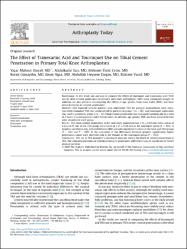| dc.contributor.author | Dinçel, Yaşar Mahsut | |
| dc.contributor.author | Sarı, Abdulkadir | |
| dc.contributor.author | Çetin, Mehmet Ümit | |
| dc.contributor.author | Günaydın, Burak | |
| dc.contributor.author | Ağca, E. | |
| dc.contributor.author | Doğan, A.H. | |
| dc.contributor.author | Varol, R. | |
| dc.date.accessioned | 2022-05-11T14:36:15Z | |
| dc.date.available | 2022-05-11T14:36:15Z | |
| dc.date.issued | 2020 | |
| dc.identifier.issn | 2352-3441 | |
| dc.identifier.uri | https://doi.org/10.1016/j.artd.2020.04.010 | |
| dc.identifier.uri | https://hdl.handle.net/20.500.11776/8422 | |
| dc.description.abstract | Background: In this study, our aim was to compare the effects of tourniquet and tranexamic acid (TXA) use on tibial cement penetration in primary total knee arthroplasty (TKA) using radiograph images. In addition, we also aimed at investigating the effects of age, gender, body mass index (BMI), and bone mineral density on cement penetration. Methods: One hundred seventy patients who underwent TKA for primary osteoarthritis were retrospectively evaluated. TXA was administered to patients in group 1 (n = 96), and tourniquet application was used in patients in group 2 (n = 74). Tibial cement penetration was evaluated radiologically on a total of 4 zones: 2 anteroposterior and 2 lateral zones. In addition, age, gender, BMI, and bone mineral density were recorded in each group. Results: The mean cement penetration in the total study population was 2.34 ± 0.24 mm, with a mean of 2.33 ± 0.25 mm in the TXA group and a mean of 2.35 ± 0.24 mm in the tourniquet group (P = .453). A negative correlation was detected between BMI and anteroposterior 1 values in the total and TXA groups (P = .022 and P = .029). In the evaluation of the differences between genders, significantly higher penetration values were observed only in the females in the tourniquet group (P = .024). Conclusions: The use of TXA instead of a tourniquet does not reduce the depth of cement penetration in TKA. The clinical implications of individual-induced penetration differences may be significant for future implant survival. © 2020 The Authors | en_US |
| dc.language.iso | eng | en_US |
| dc.publisher | Elsevier Inc | en_US |
| dc.identifier.doi | 10.1016/j.artd.2020.04.010 | |
| dc.rights | info:eu-repo/semantics/openAccess | en_US |
| dc.subject | Cement penetration | en_US |
| dc.subject | Total knee arthroplasty | en_US |
| dc.subject | Tourniquet | en_US |
| dc.subject | Tranexamic acid | en_US |
| dc.subject | bone cement | en_US |
| dc.subject | tranexamic acid | en_US |
| dc.subject | age | en_US |
| dc.subject | aged | en_US |
| dc.subject | Article | en_US |
| dc.subject | body mass | en_US |
| dc.subject | bone density | en_US |
| dc.subject | bone radiography | en_US |
| dc.subject | drug effect | en_US |
| dc.subject | female | en_US |
| dc.subject | gender | en_US |
| dc.subject | human | en_US |
| dc.subject | major clinical study | en_US |
| dc.subject | male | en_US |
| dc.subject | osteoarthritis | en_US |
| dc.subject | priority journal | en_US |
| dc.subject | tibia | en_US |
| dc.subject | total knee arthroplasty | en_US |
| dc.title | The Effect of Tranexamic Acid and Tourniquet Use on Tibial Cement Penetration in Primary Total Knee Arthroplasties | en_US |
| dc.type | article | en_US |
| dc.relation.ispartof | Arthroplasty Today | en_US |
| dc.department | Fakülteler, Tıp Fakültesi, Cerrahi Tıp Bilimleri Bölümü, Ortopedi ve Travmatoloji Ana Bilim Dalı | en_US |
| dc.identifier.volume | 6 | en_US |
| dc.identifier.issue | 3 | en_US |
| dc.identifier.startpage | 422 | en_US |
| dc.identifier.endpage | 426 | en_US |
| dc.institutionauthor | Dinçel, Yaşar Mahsut | |
| dc.institutionauthor | Sarı, Abdulkadir | |
| dc.institutionauthor | Günaydın, Burak | |
| dc.institutionauthor | Ağca, E. | |
| dc.institutionauthor | Doğan, A.H. | |
| dc.institutionauthor | Varol, R. | |
| dc.relation.publicationcategory | Makale - Uluslararası Hakemli Dergi - Kurum Öğretim Elemanı | en_US |
| dc.authorscopusid | 55994580900 | |
| dc.authorscopusid | 57196712908 | |
| dc.authorscopusid | 57208565301 | |
| dc.authorscopusid | 56421955000 | |
| dc.authorscopusid | 57217246933 | |
| dc.authorscopusid | 57217248204 | |
| dc.authorscopusid | 57217248234 | |
| dc.identifier.scopus | 2-s2.0-85086902244 | en_US |



















